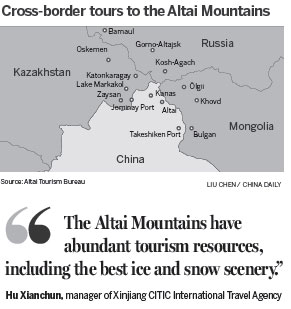Airy scenes lure tourists north
Updated: 2016-07-04 08:16
By Su Zhou in Beijing and Mao Weihua in Urumqi(China Daily)
|
|||||||||
Xinjiang beckons visitors to experience life in four countries along new routes
China's northwestern Xinjiang Uygur autonomous region is expected to get more high-end visitors after the launch of cross-border tours to the Altai Mountains, where China, Russia, Mongolia and Kazakhstan come together.
With the approval of the Altai area as a cross-border tourism cooperation zone, more favorable policies on visas, transportation, and tax-free shopping will be introduced for the convenience of tourists from the four countries.
Tourists can choose to travel between China, Russia, Mongolia and Kazakhstan, or take a tour with multiple stops in various places in the Altai Mountain area.
According to the regional tourism authority, in 2016 alone 15 groups will travel between China and Mongolia; 10 groups will cross the borders of China, Mongolia and Russia; eight groups will travel between China and Kazakhstan; and five will include China, Mongolia, Russia and Kazakhstan.

The name Altai comes from Mongolian and means "gold mountain". The area covers Altai in China's Xinjiang region, Altai Krai and the Altai Republic in Russia, the East Kazakhstan region of Kazakhstan, and the Bayan-Olgii and Khovd provinces of Mongolia, where more than 5 million people occupy 780,000 square kilometers.
Yang Xinfeng, deputy director of the Altai Tourism Bureau, said the bureau promoted the cross-border routes to tourists starting last year, and the market has responded vigorously.
"The first cross-border trip, a group driving their own cars between China and Mongolia, started in July last year. So far, we've had nearly 300 tourists participating in these routes," Yang said. "Cross-border tourism has contributed to Altai tourism.
"In 2015, we received 179,600 inbound visits from tourists, an increase of 8.95 percent year-on-year. The inbound tourism revenue reached 294 million yuan ($44.2 million) in 2015, up 8.85 percent."
"Still, bottlenecks are there," Yang said. "China and the other three countries haven't mutually recognized driver's licenses, which limits the development of driving tours around the Altai Mountains. The visa application process is also time-consuming and expensive."
Hu Xianchun, manager of Xinjiang CITIC International Travel Agency, said the cross-border travel routes are not just for tourists within Xinjiang but are open to the whole country.
"The Altai Mountains have abundant tourism resources, including the best ice and snow scenery," Hu said.
"However, the price is still relatively high. So it is more popular among high-end tourists instead of the general public," he said.
A 14-day standard tour costs around 17,000 yuan, while a driving tour costs more than 30,000 yuan, Hu estimated.
Hu said the tourism industry in Xinjiang is facing some downward pressure, and the cross-border travel routes will be a stimulator.
"Compared with other tourism destinations, the transportation cost in Xinjiang is relatively high," Hu said.
"Besides, Xinjiang is not a tourism destination that will attract tourists all year. The best time to visit Xinjiang is from June to August. This is a relatively small window for us," he said.
Contact the writers at suzhou@chinadaily.com.cn
(China Daily 07/04/2016 page4)
Today's Top News
China-UK ties to remain strong despite Brexit: envoy
Gove denies treachery as he pitches to be next PM
Theresa May among British PM hopefuls
Boris Johnson quits party leadership contest
UK parties head for leadership battles
Terrorist attack in Turkey reinforces need for unity
New British PM to be in place by Sept 9
Labour's Jeremy Corbyn loeses no-confidence vote
Hot Topics
Lunar probe , China growth forecasts, Emission rules get tougher, China seen through 'colored lens', International board,
Editor's Picks

|

|

|

|

|

|







